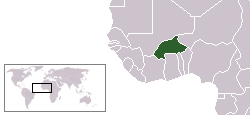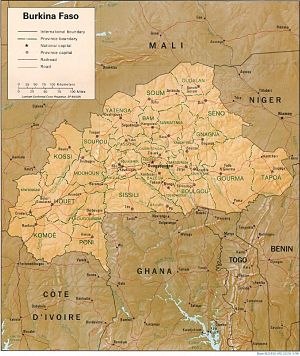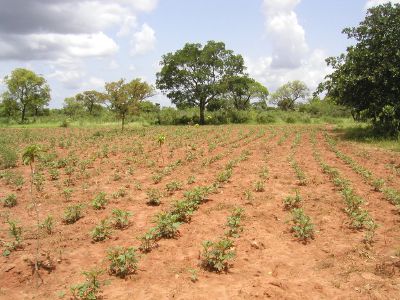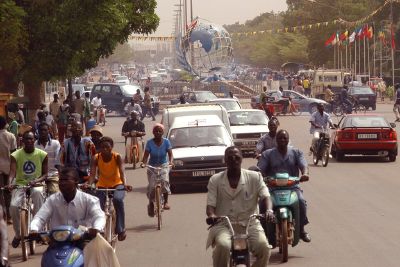Burkina Faso
 From Nwe
From Nwe | Burkina Faso | ||||||
|---|---|---|---|---|---|---|
|
||||||
| Motto: "Unité-Progrès-Justice" ("Unity, Progress, Justice") |
||||||
| Anthem: Une Seule Nuit (French) One Single Night – Thomas Sankara |
||||||

|
||||||
| Capital (and largest city) |
Ouagadougou 12°20′N 1°40′W |
|||||
| Official languages | French | |||||
| Recognized regional languages | Mòoré, Dioula (Bambara) | |||||
| Demonym | Burkinabé (also Burkinabè and Burkinabe) | |||||
| Government | Unitary provisional government under a military junta | |||||
| - | President | Paul-Henri Sandaogo Damiba | ||||
| - | Prime Minister | Albert Ouédraogo | ||||
| Establishment | ||||||
| - | from France | 5 August 1960 | ||||
| Area | ||||||
| - | Total | 274,200 km² (74th) 105,869 sq mi |
||||
| - | Water (%) | 0.146 % | ||||
| Population | ||||||
| - | 2021 estimate | 21,382,659[1] (59th) | ||||
| - | 2006 census | 14,017,262 | ||||
| - | Density | 64/km² (137th) 163,63/sq mi |
||||
| GDP (PPP) | 2020 estimate | |||||
| - | Total | $45.339 billion | ||||
| - | Per capita | $2,207[2] | ||||
| GDP (nominal) | 2020 estimate | |||||
| - | Total | $16.226 billion | ||||
| - | Per capita | $926 | ||||
| Gini (2020) | 35.3[1] | |||||
| Currency | West African CFA franc (XOF) |
|||||
| Time zone | (UTC+0) | |||||
| Internet TLD | .bf | |||||
| Calling code | +226 | |||||
Burkina Faso is a landlocked nation in West Africa. It is surrounded by six countries: Mali to the north, Niger to the east, Benin to the southeast, Togo and Ghana to the south, and Côte d'Ivoire to the southwest. Formerly Haute-Volta it was a colony of French West Africa, before becoming the Republic of Upper Volta, it was renamed in 1984 by then President Thomas Sankara using native words meaning "the land of upright and honest people." The inhabitants are known as Burkinabé.
Governmental instability during the 1970s and 1980s was followed by multiparty elections in the early 1990s, though one party still dominates the politics of the nation. Despite the greater political stability, Burkina Faso is still troubled by intermittent droughts, tropical diseases and HIV/AIDS, low worldwide prices for cotton (one of its major cash exports), poverty, illiteracy, and uneven population density (very high in the capital while huge areas are deserted).
Geography
Burkina Faso is surrounded by six countries: Mali to the north, Niger to the east, Benin to the southeast, Togo and Ghana to the south, and Côte d'Ivoire to the southwest. It lies between the Sahara Desert and the Gulf of Guinea, south of the loop of the Niger River. The land is green in the south, with forests and fruit trees, and desert in the north.
Most of the country is a gently undulating landscape with a few isolated hills. The southwest forms a sandstone massif, where the highest peak is found: Ténakourou, 2,450 ft (749 m). The massif is bordered by sheer cliffs. The difference between the highest and lowest terrain is no greater than 2,000 ft (600 m). Burkina Faso is therefore a relatively flat country, with a very few localized exceptions.
The country owed its former name of Upper Volta to three rivers that cross it: the Mouhoun (formerly called the Black Volta), the Nakambé (the White Volta), and the Nazinon (the Red Volta). The Mouhoun, along with the Comoé that flows to the southwest, is the country's only river to flow year-round. The basin of the Niger River also drains 27 percent of the country's surface. Its tributaries are seasonal streams, flowing for four to six months a year, but can cause floods. The country also contains numerous lakes. Still, droughts are often a problem, especially in the north.
The country's game preserves - the most important of which are Arly, Nazinga, and W National Park - contain lions, elephants, hippopotamus, monkeys, warthogs, and antelopes. Tourism is not well developed.
Climate



Burkina Faso has a primarily tropical climate with two very distinct seasons: the rainy season, which lasts approximately four months (May/June to September), and the dry season during which the harmattan blows, a hot dry wind from the Sahara.
Three major climatic zones can be defined:
- The Sahel Zone in the north, which typically receives less than 24 in. (600 mm) rainfall a year. A relatively dry tropical savanna, the Sahel extends beyond the borders of Burkina Faso, from the Horn of Africa to the Atlantic Ocean, and borders the Sahara to its north, and the fertile region of the Sudan to the south.
- The Sudan-Sahel region, a transitional zone with regards to rainfall and temperature.
- The Sudan-Guinea zone farther to the south, which receives more than 35 in. (900 mm) of rain a year and has cooler average temperatures.
History
Prehistory
Like all of Western Africa, Burkina Faso was populated early, notably by hunter-gatherers in the northwestern part of the country (12,000 to 5,000 B.C.E.). Agricultural settlements appeared between 3600 and 2600 B.C.E. The use of iron, ceramics, and polished stone developed between 1500 and 1000 B.C.E. There are remains of high walls in the southwest (as well as in Côte d'Ivoire).
Probably in the late 1400s C.E. the Mossi invaded the area on horseback and occupied the plateau in the center of the country. Their further spread was limited by sleeping sickness, which affected the horses. The Mossi integrated with the essentially farming ethnic groups they conquered, incorporating many of their religious practices. During this period, slaves captured on raids were sent north to Mali or south to the Atlantic coast, whence they were shipped to the Americas, especially Brazil.
From colony to independence
In 1896, the Mossi kingdom of Ouagadougou became a French protectorate after being defeated by French forces. In 1898, the majority of the region corresponding to Burkina Faso today was conquered, though there were periodic revolts by groups resisting taxation, centralized rule, forced labor, and military conscription. In 1904, these territories were integrated into French West Africa. Originally administered as part of Côte d'Ivoire, they became a separate colony in 1919. The new colony of Upper Volta was broken up in 1932 and shared between Côte d’Ivoire, Mali, and Niger.
In 1947 Haute-Volta (Upper Volta) was re-created with its pre-1932 boundaries, and in 1958, it achieved self-government and became a republic and member of the Franco-African Community. Full independence was attained in 1960. The country's first military coup occurred in 1966; it returned to civilian rule in 1978. There was another coup in 1980, which in turn was overthrown in 1982. A counter-coup was launched in 1983, which left the left-leaning Captain Thomas Sankara in charge. Blaise Compaoré came to power in 1987 after a coup d'état that killed Sankara.
On October 31, 2014, President Compaoré, facing mounting pressure, resigned after 27 years in office. In the following years there was political instability with several coups.
In 2022, The Patriotic Movement for Safeguard and Restoration (MPSR) supported by the military declared itself to be in power. The military junta restored the constitution and appointed Paul-Henri Sandaogo Damiba as interim president. In the aftermath of the coup, ECOWAS and African Union suspended Burkina Faso's membership. On February 10, the Constitutional Council declared Paul-Henri Sandaogo Damiba President of Burkina Faso and he was sworn in on February 16. On March 1, 2022, the junta approved a charter allowing a military-led transition of 3 years. The charter provides for the transition process to be followed by the holding of elections.
Government

The constitution of 1991 established a semi-presidential government with an Assembly that can be dissolved by the president, who is elected for a term of five years. In 2000 a constitutional amendment reduced the presidential term from seven to five years.
The prime minister is head of government and is appointed by the president with the approval of the National Assembly. He is responsible for recommending a cabinet for appointment by the president
Burkina Faso is divided into 13 regions, 45 provinces, and 301 departments. Each region is administered by a governor.
Foreign relations
Burkina Faso is a member of the G5 Sahel, Community of Sahel–Saharan States, La Francophonie, Organisation of Islamic Cooperation, and United Nations. It is currently suspended from ECOWAS and the African Union.
Economy

Burkina Faso is one of the poorest countries in the world. This can partly be attributed to population growth and arid soil. Agriculture represents 32 percent of its gross domestic product and occupies 80 percent of the working population. It consists mostly of livestock but also, especially in the south and southwest, crops such as sorghum, millet, maize (corn), peanuts, rice, and cotton, which is the major cash crop. Burkino Faso has been a leader in opposing cotton subsidies by the developed countries to their producers, on the grounds that subsidies encourage dumping, which results in lower world demand and prices. Some farmers in Burkina Faso are threatening to stop raising the crop because of the falling prices. An estimated three million people depend on cotton for their livelihood. The government is also trying to increase yield with better seeds and to find other uses for the cotton, such as making cooking oil.
Lack of work opportunities causes a high rate of emigration: for example, three million Burkinabe lived in Côte d'Ivoire until 2002, sending home tens of billions of CFA francs each year. The crisis in Côte d'Ivoire led to the return of 300,000 migrants.
Burkina is attempting to improve the economy by developing its mineral resources, improving its infrastructure, making its agricultural and livestock sectors more productive and competitive, and stabilizing the supplies and prices of food grains.
Manufacturing is limited to cotton and food processing (mainly in Bobo-Dioulasso). Some factories are privately owned, and others are set to be privatized. The deposits of manganese, zinc, and gold have attracted the interest of international mining firms.
Demographics




The Burkinabe belong to two major West African language and cultural groups—the Voltaic and the Mande. The Voltaic are far more numerous and include the Mossi, who make up about half of the population and are concentrated on the Mossi Plateau in the center of the country.
The population is concentrated in the south and center of the country, sometimes exceeding 125 per sq. mi. (48 per sq. km). This high population density causes annual migrations of hundreds of thousands for seasonal employment, especially during the dry season.
Approximately 50 percent of the population is Muslim; Christians account for about 25 percent, and followers of traditional African religions (typically animism of various forms) make up about 25 percent. Many Christians and Muslims incorporate elements of animism into their religious practices. Most of the people in rural areas practice animism.
French is the official language, but the majority of the people speak ethnic tongues, of which there are about 60.
Women occupy a subordinate position and experience discrimination in education, jobs, property, and family rights. Women still do much of the subsistence farming work.
The country is a source, transit, and destination country for internationally trafficked persons, including children. Children from Mali often are trafficked through Burkina Faso to Cote d'Ivoire. Destinations for trafficked children from Burkina Faso include Mali, Cote d'Ivoire, Ghana, Benin, and Nigeria.
A large proportion of children work, largely as domestic servants or in the agricultural or mining sectors, where working conditions are harsh. Children commonly work with their parents in rural areas or in family-owned small businesses in villages and cities.
Education
Education is technically free and officially mandatory until the age of 16; however, few Burkinabé have had formal education. Though schooling is free, attendance is not enforced, and only about 35 percent of Burkina's primary school-age children receive a basic education. Children are responsible for paying for school supplies, which often cost more than tuition. Many parents cannot afford to lose a child's labor in the fields or at other jobs.
Girls make up slightly more than one-third of the student population in primary schools. Schools in rural areas have even lower percentages of female students, and illiteracy for girls in the rural areas is as high as 95 percent. The government promotes primary education for girls through encouragement of donor scholarships, school feeding programs, and information campaigns to change societal attitudes toward educating girls.
Institutions of higher education include the University of Ouagadougou, the Polytechnical University in Bobo-Dioulasso, and the Koudougou Ecole Normale Superieure.
Culture

Literature in Burkina Faso is based on the oral tradition, which remains important. In 1934, during French occupation, Dim-Dolobsom Ouedraogo published his Maximes, pensées et devinettes mossi (Maximes, Thoughts and Riddles of the Mossi), a record of the oral history of the Mossi people. The oral tradition continued to have an influence on Burkinabè writers in the post-independence Burkina Faso of the 1960s, such as Nazi Boni and Roger Nikiema. The 1960s saw a growth in the number of playwrights being published. Since the 1970s, literature has developed in Burkina Faso with many more writers being published.
The theatre of Burkina Faso combines traditional Burkinabè performance with the colonial influences and post-colonial efforts to educate rural people to produce a distinctive national theatre. Traditional ritual ceremonies of the many ethnic groups in Burkina Faso have long involved dancing with masks. Western-style theatre became common during colonial times, heavily influenced by French theatre. With independence came a new style of theatre inspired by forum theatre aimed at educating and entertaining Burkina Faso's rural people.
Arts and crafts

In addition to several rich traditional artistic heritages among the peoples, there is a large artist community in Burkina Faso, especially in Ouagadougou. Much of the crafts produced are for the country's growing tourist industry.
Burkina Faso also hosts the International Art and Craft Fair, Ouagadougou. It is better known by its French name as SIAO, Le Salon International de l' Artisanat de Ouagadougou, and is one of the most important African handicraft fairs.
Cuisine

Typical of West African cuisine, Burkina Faso's cuisine is based on staple foods of sorghum, millet, rice, maize, peanuts, potatoes, beans, yams and okra. The most common sources of animal protein are chicken, chicken eggs and fresh water fish. A typical Burkinabè beverage is Banji or Palm Wine, which is fermented palm sap; and Zoom-kom, or "grain water" purportedly the national drink of Burkina Faso. Zoom-kom is milky-looking and whitish, having a water and cereal base, best drunk with ice cubes. In the more rural regions, in the outskirts of Burkina, you would find Dolo, which is drink made from fermented millet.
Cinema
The cinema of Burkina Faso is an important part of West African and African film industry.[3] Burkina's contribution to African cinema started with the establishment of the film festival FESPACO (Festival Panafricain du Cinéma et de la Télévision de Ouagadougou), which was launched as a film week in 1969. Many of the nation's filmmakers are known internationally and have won international prizes.
For many years the headquarters of the Federation of Panafrican Filmmakers (FEPACI) was in Ouagadougou, rescued in 1983 from a period of moribund inactivity by the enthusiastic support and funding of President Sankara. (In 2006 the Secretariat of FEPACI moved to South Africa, but the headquarters of the organization is still in Ouagadougou.) Among the best known directors from Burkina Faso are Gaston Kaboré, Idrissa Ouedraogo and Dani Kouyate.[4] Burkina produces popular television series such as Les Bobodiouf. Internationally known filmmakers such as Ouedraogo, Kabore, Yameogo, and Kouyate make popular television series.
Sports
Sport in Burkina Faso is widespread and includes soccer, basketball, cycling, rugby union, handball, tennis, boxing, and martial arts. Soccer is the most popular sport in Burkina Faso, played both professionally, and informally in towns and villages across the country. The national team is nicknamed "Les Etalons" ("the Stallions") in reference to the legendary horse of Princess Yennenga.
In 1998, Burkina Faso hosted the Africa Cup of Nations for which the Omnisport Stadium in Bobo-Dioulasso was built. Burkina Faso qualified for the 2013 African Cup of Nations]]in South Africa and reached the final, but then lost to Nigeria 0–1.
Basketball is another sport which enjoys much popularity for both men and women.
At the 2020 Summer Olympics, the athlete Hugues Fabrice Zango won Burkina Faso's first Olympic medal, winning bronze in the men's triple jump. Cricket is also picking up in Burkina Faso with Cricket Burkina Faso running a 10 club league.
Notes
- ↑ 1.0 1.1 CIA, Burkina Faso World Factbook. Retrieved April 1, 2022.
- ↑ Report for Selected Countries and Subjects International Monetary Fund. Retrieved April 1, 2022.
- ↑ Lieve Spaas, The Francophone Film: A Struggle for Identity (Manchester University Press, 2001, ISBN 978-0719058615).
- ↑ Teresa Hoefert Turégano, African Cinema and Europe: Close-Up on Burkina Faso (Florence: European Press Academic, 2004, ISBN 978-8883980312)..
References
ISBN links support NWE through referral fees
- Bohannan, Paul and Philip Curtin, Africa and Africans, 3rd ed. Prospect Heights, IL: Waveland Press, 1988. ISBN 0881333476
- Cutter, Charles H. Africa 2006. Harpers Ferry, WV: Stryker-Post Publications, 2006. ISBN 1887985727
- Harsch, Ernest. Burkina Faso: A History of Power, Protest, and Revolution. Zed Books, 2017. ISBN 978-1786991355
- Roy, Christopher D., and Thomas G.B. Wheelock. Land of the Flying Masks: Art & Culture in Burkina Faso. Prestel Pub, 2007. ISBN 978-3791335148
- Sankara, Thomas. We Are the Heirs of the World's Revolutions. Pathfinder Press, 2007. ISBN 978-0873489898
- Spaas, Lieve. The Francophone Film: A Struggle for Identity. Manchester University Press, 2001. ISBN 978-0719058615
- Turégano, Teresa Hoefert. African Cinema and Europe: Close-Up on Burkina Faso. Florence: European Press Academic, 2004. ISBN 978-8883980312
External links
All links retrieved March 31, 2022.
- Burkina Faso, BURKINABE.
- Burkina Faso literature at a glance, The University of Western Australia.
- Burkina Faso, Encyclopedia of the Nations.
- Burkina Faso Premier Ministère (in French).
- Burkina Faso - Top News, allAfrica.
- Burkina Faso country profile, British Broadcasting Company.
- Burkina Faso, CIA The World Factbook.
- Burkina Faso Page, African Studies Center.
- Maps of Burkina Faso, World Atlas.
Credits
New World Encyclopedia writers and editors rewrote and completed the Wikipedia article in accordance with New World Encyclopedia standards. This article abides by terms of the Creative Commons CC-by-sa 3.0 License (CC-by-sa), which may be used and disseminated with proper attribution. Credit is due under the terms of this license that can reference both the New World Encyclopedia contributors and the selfless volunteer contributors of the Wikimedia Foundation. To cite this article click here for a list of acceptable citing formats.The history of earlier contributions by wikipedians is accessible to researchers here:
- Burkina_Faso history
- Geography_of_Burkina_Faso history
The history of this article since it was imported to New World Encyclopedia:
- History of "Burkina Faso"
Note: Some restrictions may apply to use of individual images which are separately licensed.
↧ Download as ZWI file | Last modified: 02/03/2023 23:04:19 | 50 views
☰ Source: https://www.newworldencyclopedia.org/entry/Burkina_Faso | License: CC BY-SA 3.0
 ZWI signed:
ZWI signed:

 KSF
KSF